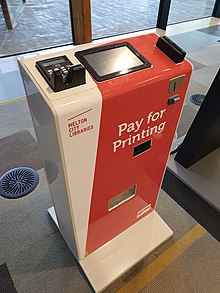


An interactive kiosk is a computer terminal featuring specialized hardware and software that provides access to information and applications for communication, commerce, entertainment, or education.
By 2010, the largest bill pay kiosk network was AT&T, which allowed for phone customers to pay their bills. Verizon and Sprint have also introduced similar units over time.

Early interactive kiosks sometimes resembled telephone booths, but have been embraced by retail, food service, and hospitality to improve customer service and streamline operations. Interactive kiosks are typically placed in the high foot traffic settings such as shops, hotel lobbies, or airports.
The integration of technology allows kiosks to perform a wide range of functions, evolving into self-service kiosks. For example, kiosks may enable users to order from a shop's catalog when items are not in stock, check out a library book, look up information about products, issue a hotel key card, enter a public utility bill account number to perform an online transaction, or collect cash in exchange for merchandise. Customized components such as coin hoppers, bill acceptors, card readers, and thermal printers enable kiosks to meet the owner's specialized needs.